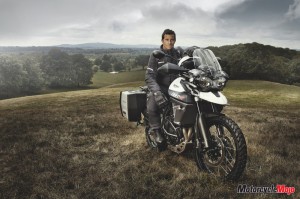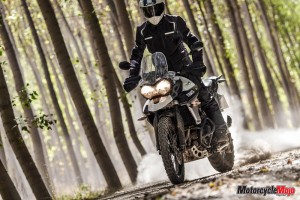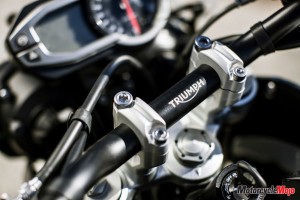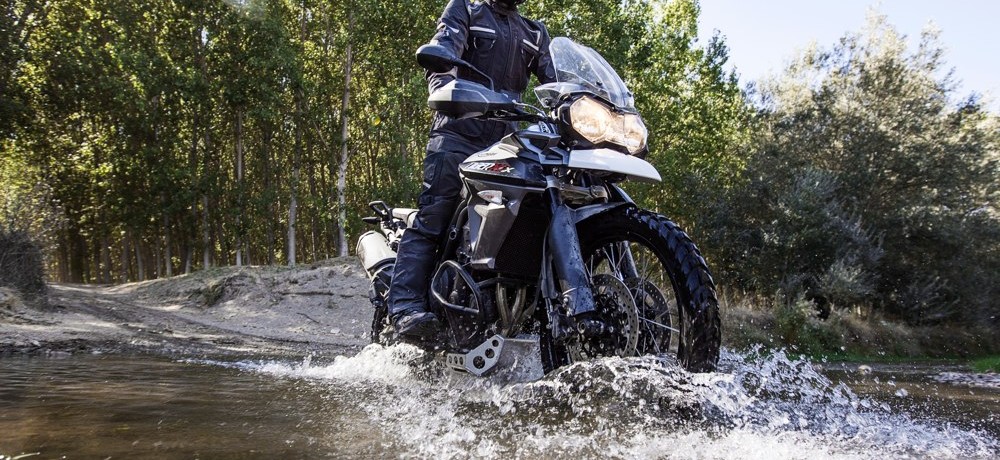Triumph thought it was time to update the Tiger 800 models and include some high-tech items at the same time. The company messed with a good thing and made it even better.
As I reflected on the past few days I had just spent with the Tiger 800 XCx, Triumph’s newest incarnation in its adventure bike line-up, I was reminded how enjoyable and versatile adventure bikes really are. The whirlwind, two-day media launch of the Tiger took us from Los Angeles to San Diego and back on a variety of roads including mountain twisties, freeways and inner-city boulevards. I spent some additional days in the South Bay area of Los Angeles and realized that adventure bikes are an ideal means of getting around town; they offer comfort, wind protection, high-performance manoeuvrability and style – the last being of obvious importance in the City of Angels.
 It was February and the weather was 24 degrees C warmer than in Ontario. As I write, it’s very hard to focus on the task at hand and evaluate the Tiger when it is so nice outside and the Tiger is sitting idle.
It was February and the weather was 24 degrees C warmer than in Ontario. As I write, it’s very hard to focus on the task at hand and evaluate the Tiger when it is so nice outside and the Tiger is sitting idle.
The new Triumph Tiger 800 XCx shares its name with a long succession of exciting motorcycles. Originally, the Tiger name was used in 1939. After a number of variations, Triumph brought the Tiger name back in 1993 with the 900 and, more recently, the 1050, which was launched in 2007. It is still one of the best long-distance upright-seated touring bikes around. The “baby Tiger,” or 800, was announced in late 2010 as a cast-wheel street motorcycle. When the Tiger 800 XC hit the market in 2011, the bike’s scope of use became nearly limitless.
To qualify myself, I have spent more than my share of time riding adventure bikes of all types, including many kilometres on the previous version of the Tiger 800 XC. I like midsize adventure bikes such as the Tiger or BMW’s 800 GS – they fit me well and are capable enough for the type of riding I like to do: exploring the backcountry, riding gravel and dirt roads and staying off the big, crowded highways as much as possible. In my world, venturing onto dirt trails may be on the dance card as well.
Interstate Mayhem
 For our first experience on the bikes, two other journos and I followed Triumph Canada’s head honcho, Chris Ellis, as we tore down the gigantic concrete slab of the I-5 freeway at 135 km/h in the HOV lane until things slowed down as we approached Oceanside. SoCal freeway riding is an experience, to say the least – the incredible volume of traffic and the speeds of the status quo are impressive. Par for the course in California, once traffic stopped, we started splitting lanes. The three-hour ride demonstrated how highway capable the 800 really is. Squirting past traffic is easy in sixth gear, and the roll-on performance at higher speeds left me happy with the new 800’s ability to accelerate past lines of cars.
For our first experience on the bikes, two other journos and I followed Triumph Canada’s head honcho, Chris Ellis, as we tore down the gigantic concrete slab of the I-5 freeway at 135 km/h in the HOV lane until things slowed down as we approached Oceanside. SoCal freeway riding is an experience, to say the least – the incredible volume of traffic and the speeds of the status quo are impressive. Par for the course in California, once traffic stopped, we started splitting lanes. The three-hour ride demonstrated how highway capable the 800 really is. Squirting past traffic is easy in sixth gear, and the roll-on performance at higher speeds left me happy with the new 800’s ability to accelerate past lines of cars.
When we first hit the freeway, I immediately noticed what I assumed was a significant increase in the bike’s power, especially from 5500 rpm up to redline. The raspy triple feels as if the engine received a boost in displacement, or the engineers slipped a turbo-charger onto the inline-triple when no one was looking. The difference is that significant. That said, it should be noted that Triumph does not claim any increase in horsepower over the previous model, but simply states that power is spread over a much broader range of rpm.
New Tech for the XCx
 Triumph’s engineering department accomplished this change by adding a ride-by-wire electronic fuel injection system that also allows for traction control, engine mode and cruise control. The actual throttle response is now ultra-quick, and the throttle has a lighter touch to it. All the adjustments to traction control, engine mode and ABS can be made via the new right and left handlebar switches.
Triumph’s engineering department accomplished this change by adding a ride-by-wire electronic fuel injection system that also allows for traction control, engine mode and cruise control. The actual throttle response is now ultra-quick, and the throttle has a lighter touch to it. All the adjustments to traction control, engine mode and ABS can be made via the new right and left handlebar switches.
Some of the benefits of the new fuel injection system are a dizzying number of settings and rider-selected configurations. The basics for the ABS and traction control are Road, Off-Road and Rider Mode. If you have the inkling, you can choose from an infinite number of variables that you can tailor to your riding ability. Four throttle maps are also available, which feature Rain, Road, Sport and Off-road to adjust throttle response and power accordingly.
Triumph proclaims advancements in “engineered sound,” which means it must meet stringent noise level standards around the globe, yet still offer the soul-stirring vibrato of a high-performance motorcycle. The company accomplished this by making its mufflers quieter, but allowing more freedom from the howl of the intake to produce a satisfying feel-good sensation when you screw on the throttle. In the process, the air intake tract has been made more efficient, and according to the Triumph technical information, the new 800 has better combustion and reduced emissions. The end result is a 17 percent increase in fuel economy.
It’s worth mentioning that the Tiger features increased alternator output to 476 watts and an additional electrical outlet to accommodate the never-ending race to affix more accessories to one’s motorcycle.
Upgraded Suspension
Wisely so, Triumph chose to upgrade the suspension on the new 800 XCx with fully adjustable WP suspension front and rear. In my opinion, the previous 800 XC lacked somewhat in the suspension department. I would hazard a guess that the first 800s were built to meet a price point and the quality of the suspension units perform accordingly.
The new forks and remote-reservoir shock are a welcome change, especially if you plan on riding great distances in off-road conditions while carrying a quantity of gear needed to survive in the boondocks. The front forks are 43 mm inverted-style units that have easy-to-access click adjusters
on top for compression and rebound damping. The WP remote-reservoir rear shock is equipped with adjustable preload and rebound damping.
Give Me Curves
The next day, our ride from San Diego back to L.A. took us east to Alpine, and into the hills where the roads follow the lay of the land. The corners are tight, and often banked. Road conditions varied from bumpy to billiard-table smooth and a playground for canyon racers in full leathers and slick-tired sport bikes.
The new XCx liked these roads; the tires stuck to the pavement and the suspension soaked up the bumps with aplomb, keeping the rubber planted and allowing the bike to easily hold its line. Overall, the XCx was great fun to ride.
Ultimately, we rode the Ortega Highway to Hell’s Kitchen for a burger after stopping at the overlook above Lake Elsinore. The roads were busy that Sunday, but at a brisk pace, the Tiger slipped easily past cars. The pair of two-piston Nissin calipers squeezing 308 mm discs was more than confidence-inspiring going into downhill bends. The ABS isn’t overly sensitive and works well in low-traction conditions, such as windblown sand on the tarmac. The pavement surface on many of the roads in California is smooth and consistent, making it a great place to evaluate the abilities of motorcycles; corner after corner, the Tiger stayed put in its tracks. The ride was an all-day run, but I felt relatively fresh at the end of it.
The midsize adventure bike market is competitive. It’s no secret that the BMW 800 GS is the Tiger’s main competition, and BMW takes the adventure segment very seriously. In comparison tests, the Tiger 800 was considered by many the bike of choice in the category. The new 800 XCx is the logical next step for Triumph in order to maintain its position in this lucrative market.
I believe the Tiger 800 holds its position at the front of the class. The dramatic changes seemed to come easily by unlocking the engine’s potential, and the chassis loves its new legs. The rest of the Tiger is best left untouched. Why mess with a good thing?







































